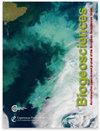根系分布预测灌木草原对降水强度的反应
IF 3.9
2区 地球科学
Q1 ECOLOGY
引用次数: 1
摘要
摘要世界各地的降水量越来越大,改变了水在土壤和植物中的流动方式。能在这些条件下维持水分吸收的植物扎根策略可能会越来越多(如灌木侵占)。然而,预测物种对气候变化的反应仍然很困难,因为我们通常不知道活跃根系的位置,也不知道它们吸收了多少水分。在这里,我们采用水示踪实验来描述禁止植物、草和灌木根系的分布。这些测量是在降水强度较低或较高的 8 米乘 8 米的野外遮蔽处进行的。我们在土壤水流模型中使用示踪剂吸收数据来估算植物根系组织在一段时间内的吸水量。据估计,在降水强度低的地块中,灌木深根吸收的水分最多(93 毫米/年-1),灌木的地上覆盖率最大(27%)。据估计,草根分布吸收的水量居中(80 毫米/年-1),草的地上覆盖率也居中(18%)。据估计,植物根系分布吸收的水分最少(79 毫米/年-1),地上覆被率最低(12%)。在高降水强度地块中,灌木和草本植物根系分布的变化方式增加了它们相对于禾本科植物的吸水量,这也预示着灌木和草本植物在这些地块中的地上生长量会增加。简而言之,不同的根系分布导致的吸水率可以预测植物的地上植被。我们的研究结果表明,对植物活跃根系分布的详细描述可以预测干旱和半干旱生态系统中植物生长对气候变化的反应。本文章由计算机程序翻译,如有差异,请以英文原文为准。
Root distributions predict shrub–steppe responses to precipitation intensity
Abstract. Precipitation events are becoming more intense around the world, changing the way water moves through soils and plants. Plant rooting strategies that sustain water uptake under these conditions are likely to become more abundant (e.g., shrub encroachment). Yet, it remains difficult to predict species responses to climate change because we typically do not know where active roots are located or how much water they absorb. Here, we applied a water tracer experiment to describe forb, grass, and shrub root distributions. These measurements were made in 8 m by 8 m field shelters with low or high precipitation intensity. We used tracer uptake data in a soil water flow model to estimate how much water respective plant root tissues absorb over time. In low-precipitation-intensity plots, deep shrub roots were estimated to absorb the most water (93 mm yr−1) and shrubs had the greatest aboveground cover (27 %). Grass root distributions were estimated to absorb an intermediate amount of water (80 mm yr−1) and grasses had intermediate aboveground cover (18 %). Forb root distributions were estimated to absorb the least water (79 mm yr−1) and had the least aboveground cover (12 %). In high-precipitation-intensity plots, shrub and forb root distributions changed in ways that increased their water uptake relative to grasses, predicting the increased aboveground growth of shrubs and forbs in these plots. In short, water uptake caused by different rooting distributions predicted plant aboveground cover. Our results suggest that detailed descriptions of active plant root distributions can predict plant growth responses to climate change in arid and semi-arid ecosystems.
求助全文
通过发布文献求助,成功后即可免费获取论文全文。
去求助
来源期刊

Biogeosciences
环境科学-地球科学综合
CiteScore
8.60
自引率
8.20%
发文量
258
审稿时长
4.2 months
期刊介绍:
Biogeosciences (BG) is an international scientific journal dedicated to the publication and discussion of research articles, short communications and review papers on all aspects of the interactions between the biological, chemical and physical processes in terrestrial or extraterrestrial life with the geosphere, hydrosphere and atmosphere. The objective of the journal is to cut across the boundaries of established sciences and achieve an interdisciplinary view of these interactions. Experimental, conceptual and modelling approaches are welcome.
 求助内容:
求助内容: 应助结果提醒方式:
应助结果提醒方式:


